
Now available: The Design and Implementation of the FreeBSD Operating System (Second Edition)
[ source navigation ] [ identifier search ] [ freetext search ] [ file search ] [ list types ] [ track identifier ]
FreeBSD/Linux Kernel Cross Reference
sys/Documentation/ABI/
Version:
- FREEBSD - FREEBSD-13-STABLE - FREEBSD-13-0 - FREEBSD-12-STABLE - FREEBSD-12-0 - FREEBSD-11-STABLE - FREEBSD-11-0 - FREEBSD-10-STABLE - FREEBSD-10-0 - FREEBSD-9-STABLE - FREEBSD-9-0 - FREEBSD-8-STABLE - FREEBSD-8-0 - FREEBSD-7-STABLE - FREEBSD-7-0 - FREEBSD-6-STABLE - FREEBSD-6-0 - FREEBSD-5-STABLE - FREEBSD-5-0 - FREEBSD-4-STABLE - FREEBSD-3-STABLE - FREEBSD22 - l41 - OPENBSD - linux-2.6 - MK84 - PLAN9 - xnu-8792
SearchContext: - none - 3 - 10
SearchContext: - none - 3 - 10
| Name | Size | Last modified (GMT) | Description | |
| Parent directory | 2013-02-02 13:13:18 | |||
| obsolete/ | 2013-02-02 13:13:57 | |||
| removed/ | 2013-02-02 13:14:02 | |||
| stable/ | 2013-02-02 13:14:02 | |||
| testing/ | 2013-02-02 13:14:01 | |||
| README | 3284 bytes | 2012-12-25 01:40:34 |
1 This directory attempts to document the ABI between the Linux kernel and 2 userspace, and the relative stability of these interfaces. Due to the 3 everchanging nature of Linux, and the differing maturity levels, these 4 interfaces should be used by userspace programs in different ways. 5 6 We have four different levels of ABI stability, as shown by the four 7 different subdirectories in this location. Interfaces may change levels 8 of stability according to the rules described below. 9 10 The different levels of stability are: 11 12 stable/ 13 This directory documents the interfaces that the developer has 14 defined to be stable. Userspace programs are free to use these 15 interfaces with no restrictions, and backward compatibility for 16 them will be guaranteed for at least 2 years. Most interfaces 17 (like syscalls) are expected to never change and always be 18 available. 19 20 testing/ 21 This directory documents interfaces that are felt to be stable, 22 as the main development of this interface has been completed. 23 The interface can be changed to add new features, but the 24 current interface will not break by doing this, unless grave 25 errors or security problems are found in them. Userspace 26 programs can start to rely on these interfaces, but they must be 27 aware of changes that can occur before these interfaces move to 28 be marked stable. Programs that use these interfaces are 29 strongly encouraged to add their name to the description of 30 these interfaces, so that the kernel developers can easily 31 notify them if any changes occur (see the description of the 32 layout of the files below for details on how to do this.) 33 34 obsolete/ 35 This directory documents interfaces that are still remaining in 36 the kernel, but are marked to be removed at some later point in 37 time. The description of the interface will document the reason 38 why it is obsolete and when it can be expected to be removed. 39 40 removed/ 41 This directory contains a list of the old interfaces that have 42 been removed from the kernel. 43 44 Every file in these directories will contain the following information: 45 46 What: Short description of the interface 47 Date: Date created 48 KernelVersion: Kernel version this feature first showed up in. 49 Contact: Primary contact for this interface (may be a mailing list) 50 Description: Long description of the interface and how to use it. 51 Users: All users of this interface who wish to be notified when 52 it changes. This is very important for interfaces in 53 the "testing" stage, so that kernel developers can work 54 with userspace developers to ensure that things do not 55 break in ways that are unacceptable. It is also 56 important to get feedback for these interfaces to make 57 sure they are working in a proper way and do not need to 58 be changed further. 59 60 61 How things move between levels: 62 63 Interfaces in stable may move to obsolete, as long as the proper 64 notification is given. 65 66 Interfaces may be removed from obsolete and the kernel as long as the 67 documented amount of time has gone by. 68 69 Interfaces in the testing state can move to the stable state when the 70 developers feel they are finished. They cannot be removed from the 71 kernel tree without going through the obsolete state first. 72 73 It's up to the developer to place their interfaces in the category they 74 wish for it to start out in.
[ source navigation ] [ identifier search ] [ freetext search ] [ file search ] [ list types ] [ track identifier ]